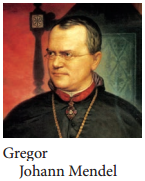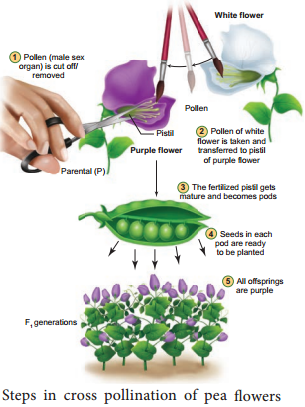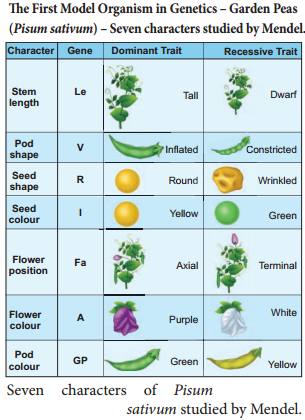Learninsta presents the core concepts of Biology with high-quality research papers and topical review articles.
Monohybrid, Dihybrid, Cross, Backcross And Testcross
Monohybrid inheritance is the inheritance of a single character i.e. plant height. It involves the inheritance of two alleles of a single gene. When the F1 generation was selfed Mendel noticed that 787 of 1064 F2 plants were tall, while 277 of 1064 were dwarf. The dwarf trait disappeared in the F1 generation only to reappear in the F2 generation.
The term genotype is the genetic constitution of an individual. The term phenotype refers to the observable characteristic of an organism. In a genetic cross the genotypes and phenotypes of offspring, resulting from combining gametes during fertilization can be easily understood with the help of a diagram called Punnett’s Square named after a British Geneticist Reginald C.Punnett.
It is a graphical representation to calculate the probability of all possible genotypes of offsprings in a genetic cross. The Law of Dominance and the Law of Segregation give suitable explanation to Mendel’s monohybrid cross.
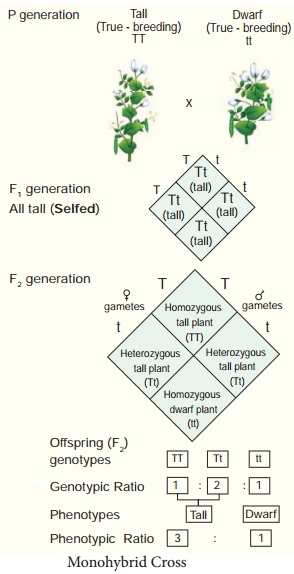
Reciprocal cross:
In one experiment, the tall pea plants were pollinated with the pollens from a true-breeding dwarf plants, the result was all tall plants. When the parental types were reversed, the pollen from a tall plant was used to pollinate a dwarf pea plant which gave only tall plants.
The result was the same – All tall plants. Tall (img 1) x Dwarf (img 2) and Tall (img 3) x Dwarf (img 4) matings are done in both ways which are called reciprocal crosses. The results of the reciprocal crosses are the same. So it was concluded that the trait is not sex dependent. The results of Mendel’s monohybrid crosses were not sex dependent.
The gene for plant height has two alleles:
Tall (T) x Dwarf (t). The phenotypic and genotypic analysis of the crosses has been shown by Checker board method or by Forkline method.
Mendel’s analytical and empirical approach
Mendel chose two contrasting traits for each character. So it seemed logical that two distinct factors exist. In F1 the recessive trait and its factors do not disappear and they are hidden or masked only to reappear in ¼ of the F2 generation. He concluded that tall and dwarf alleles of F1 heterozygote segregate randomly into gametes.
Mendel got 3:1 ratio in F2 between the dominant and recessive trait. He was the fist scientist to use this type of quantitative analysis in a biological experiment. Mendel’s data is concerned with the proportions of offspring.
Mendel’s analytical approach is truly an outstanding scientifi achievement. His meticulous work and precisely executed breeding experiments proposed that discrete particulate units of heredity are present and they are transmitted from one generation to the other.
Now they are called as genes. Mendel’s experiments were well planned to determine the relationships which govern hereditary traits. This rationale is called an empirical approach. Laws that were arrived from an empirical approach is known as empirical laws.
Test cross
Test cross is crossing an individual of unknown genotype with a homozygous recessive. In Mendel’s monohybrid cross all the plants are tall in F1 generation. In F2 tall and dwarf plants in F3 and F4 generations.
So he concluded that the genotype of dwarf was homozygous (tt). The genotypes of tall plants TT or Tt from F1 and F2 cannot be predicted.
But how we can tell if a tall plant is homozygous or heterozygous? To determine the genotype of a tall plant Mendel crossed the plants from F2 with the homozygous recessive dwarf plant. This he called a test cross. The progenies of the test cross can be easily analysed to predict the genotype of the plant or the test organism.
Thus in a typical test cross an organism (pea plants) showing dominant phenotype (whose genotype is to be determined) is crossed with the recessive parent instead of self crossing. Test cross is used to identify whether an individual is homozygous or heterozygous for dominant character.
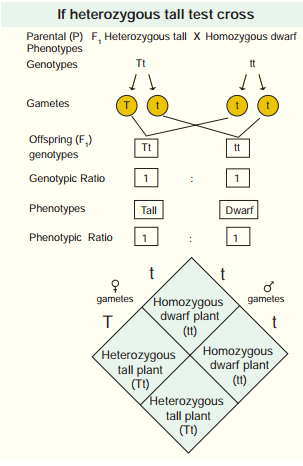
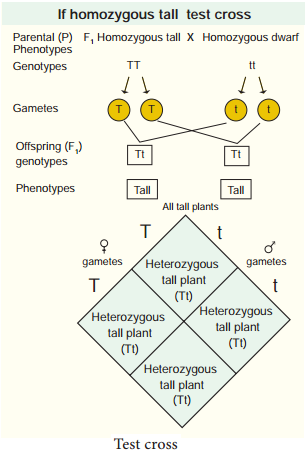
Back cross
- Back cross is a cross of F1 hybrid with any one of the parental genotypes. The back cross is of two types; they are dominant back cross and recessive back cross.
- It involves the cross between the F1 offspring with either of the two parents.
- When the F1 offsprings are crossed with the dominant parents all the F2 develop dominant character and no recessive individuals are obtained in the progeny.
- If the F1 hybrid is crossed with the recessive parent individuals of both the phenotypes appear in equal proportion and this cross is specifid as test cross.
- The recessive back cross helps to identify the heterozygosity of the hybrid.
Dihybrid cross
It is a genetic cross which involves individuals differing in two characters. Dihybrid inheritance is the inheritance of two separate genes each with two alleles.
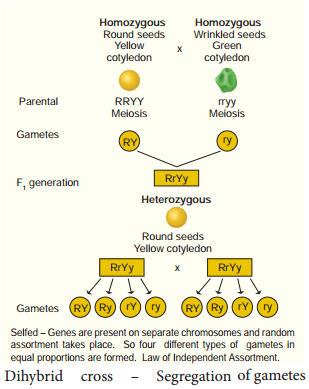
Law of Independent Assortment:
When two pairs of traits are combined in a hybrid, segregation of one pair of characters is independent to the other pair of characters. Genes that are located in different chromosomes assort independently during meiosis. Many possible combinations of factors can occur in the gametes.
Independent assortment leads to genetic diversity. If an individual produces genetically dissimilar gametes it is the consequence of independent assortment. Though independent assortment, the maternal and paternal members of all pairs were distributed to gametes, so all possible chromosomal combinations were produced leading to genetic variation.
In sexually reproducing plants/organisms, due to independent assortment, genetic variation takes place which is important in the process of evolution. The Law of Segregation is concerned with alleles of one gene but the Law of Independent Assortment deals with the relationship between genes.
The crossing of two plants diffring in two pairs of contrasting traits is called dihybrid cross. In dihybrid cross, two characters (colour and shape) are considered at a time. Mendel considered the seed shape (round and wrinkled) and cotyledon colour (yellow & green) as the two characters. In seed shape round (R) is dominant over wrinkled (r); in cotyledon colour yellow (Y) is dominant over green (γ).
Hence the pure breeding round yellow parent is represented by the genotype RRYY and the pure breeding green wrinkled parent is represented by the genotype rryy. During gamete formation the paired genes of a character assort out independently of the other pair.
During the F1 × F1 fertilization each zygote with an equal probability receives one of the four combinations from each parent. The resultant gametes thus will be genetically different and they are of the following four types:
- Yellow round (YR) – 9/16
- Yellow wrinkled (Yr) – 3/16
- Green round (yR) – 3/16
- Green wrinkled (yr) – 1/16
These four types of gametes of F1 dihybrids unite randomly in the process of fertilization and produce sixteen types of individuals in F2 in the ratio of 9:3:3:1 as shown in the fiure. Mendel’s 9:3:3:1 dihybrid ratio is an ideal ratio based on the probability including segregation, independent assortment and random fertilization.
In sexually reproducing organism/plants from the garden peas to human beings, Mendel’s fidings laid the
foundation for understanding inheritance and revolutionized the field of biology. The dihybrid cross and its result led Mendel to propose a second set of generalisations that we called Mendel’s Law of independent assortment.

The Dihybrid test cross
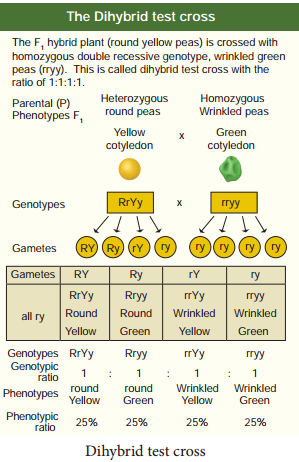
Extensions of Mendelian Genetics
Apart from monohybrid, dihybrid and trihybrid crosses, there are exceptions to Mendelian principles, i.e. the occurrence of different phenotypic ratios. The more complex patterns of inheritance are the extensions of Mendelian Genetics. There are examples where phenotype of the organism is the result of the interactions among genes.
Gene interaction:
A single phenotype is controlled by more than one set of genes, each of which has two or more alleles. This phenomenon is called Gene Interaction. Many characteristics of the organism including structural and chemical which constitute the phenotype are the result of interaction between two or more genes.
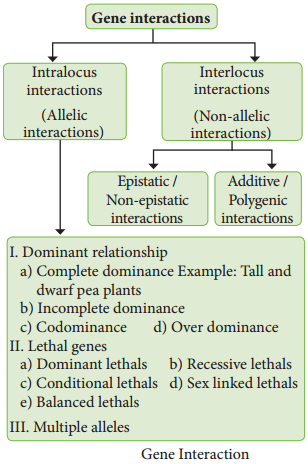
Mendelian experiments prove that a single gene controls one character. But in the post Mendelian fidings, various exception have been noticed, in which different types of interactions are possible between the genes. This gene interaction concept was introduced and explained by W. Bateson. This concept is otherwise known as Factor hypothesis or Bateson’s factor hypothesis. According to Bateson’s factor hypothesis, the gene interactions can be classifid as
- Intragenic gene interactions or Intra allelic or allelic interactions
- Intergenic gene interactions or inter allelic or non-allelic interactions
